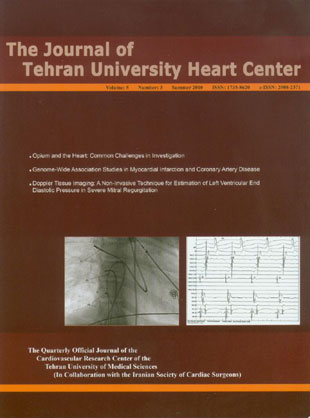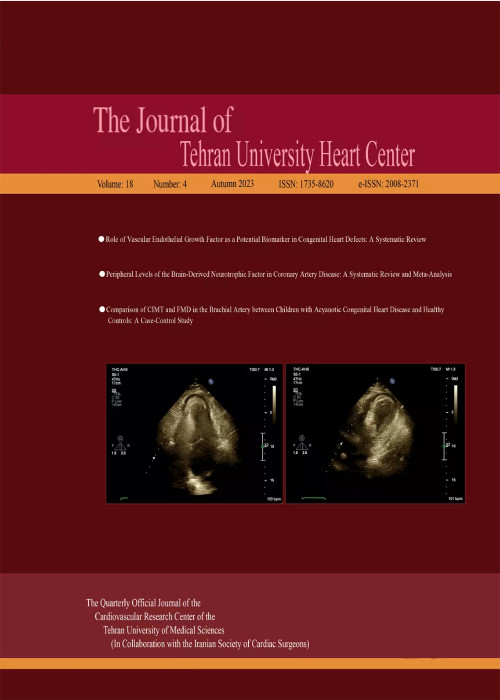فهرست مطالب

The Journal of Tehran University Heart Center
Volume:5 Issue: 3, Jul 2010
- تاریخ انتشار: 1389/05/01
- تعداد عناوین: 10
-
-
Pages 113-115
-
Pages 116-121Myocardial infarction (MI) and its major determinant, coronary artery disease (CAD), are complex diseases arising from the interaction between several genetic and environmental factors. Until recently, the genetic basis of these diseases was poorly understood. Genome-wide genetic association studies have afforded a comprehensive insight into the association between genetic variants and diseases. To date, seven genome-wide association studies have been conducted in CAD/MI, identifying thirteen genomic regions at which common genetic variants influence the predisposition to these diseases. This review article summarizes the progress achieved in the genetic basis of MI and CAD by means of genome-wide association studies and the potential clinical applications of these findings.
-
Pages 122-127BackgroundConventional Doppler measurements, including mitral inflow and pulmonary venous flow, are used to estimate left ventricular end diastolic pressure (LVEDP). However, these parameters have limitations in predicting LVEDP among patients with mitral regurgitation. This study sought to establish whether the correlation between measurements derived from tissue Doppler echocardiography and LVEDP remains valid in the setting of severe mitral regurgitation.MethodsThirty patients (mean age: 57.37 ± 13.29 years) with severe mitral regurgitation and a mean left ventricular ejection fraction (EF) of 46.0 ± 14.95 were enrolled; 16 (53.4%) patients were defined to have EF < 50% and 14 (46.6%) patients had EF ≥ 50%. Doppler signals from the mitral inflow, pulmonary venous flow, and Doppler tissue imaging indices were obtained, and LVEDP was measured invasively through cardiac catheterization.ResultsThe majority of the standard Doppler and Doppler tissue imaging indices were not significantly correlated with LVEDP in the univariate analysis. In the multiple linear regression, however, early (E) transmitral velocity to annular E'' (E/E'') ratio (ß = 1.09, p value < 0.01), E wave velocity to propagation velocity (E/Vp) ratio (ß = 7.87, p value < 0.01), and isovolumic relaxation time (ß = 0.21, p value = 0.01) were shown as independent predictors of LVEDP (R2 = 91.7%).ConclusionThe ratio of E/Vp and E/E'' ratio and also the isovolumic relaxation time could be applied properly to estimate LVEDP in mitral regurgitation patients even in the setting of severe mitral regurgitation.
-
Pages 128-131BackgroundPostoperative pulmonary dysfunction is one of the most frequent complications after cardiac surgery and it is believed to result from the use of cardiopulmonary bypass (CPB). In this study, we investigated the effect of low tidal volume ventilation during CPB on postoperative gas exchange and lung mechanics.MethodsThis prospective randomized study included 100 patients undergoing elective coronary artery bypass grafting. In 50 patients, low tidal volume ventilation [tidal volume (TV) = 3 ml/kg, respiratory rate (RR) = 12/min, fraction of inspiratory oxygen (FIO2)= 1.0, positive end expiratory pressure (PEEP) = 5 cmH2O] was applied during CPB (group I); and in the other 50 patients (group II), the lungs were open to the atmosphere without ventilation. Measurements were taken preoperatively, after CPB, and before discharge.ResultsPost-bypass PaO2 (just after CPB 85 versus75) was higher significantly in group I (P value < 0.05). Decrease in postoperative forced expiratory volume in 1 second (25% versus 30%) and forced vital capacity (32% versus 35%) was less significant in group I. Also, time to extubation (5 hrs versus 5.5 hrs) was shorter in group I.ConclusionContinued low tidal volume ventilation during CPB improved post-bypass oxygenation and lung mechanics.
-
Tricuspid Regurgitation Improvement in Relation to the Amount of Pulmonary Artery Pressure ReductionPages 132-136BackgroundGiven the common concomitance of tricuspid regurgitation (TR) with significant mitral stenosis, we aimed at exploring the relation between TR severity and pulmonary artery hypertension (PAH) in patients who underwent mitral balloon valvotomy (MBV).MethodsWe analyzed the echocardiography data of 133 consecutive patients (82.0% female, mean age 44.68 ± 12.56 years) with different degrees of TR severity that underwent MBV between April 2006 and March 2008. The pulmonary artery systolic pressure (PAPs) > 35 mmHg was considered as PAH.ResultsBefore MBV, 36.20% of the patients had moderate to severe TR, 92.5% PAH, and 18.0% right ventricular (RV) dilation (RV dimension ≥ 33 mm). After MBV, TR severity improved in 41.4%, worsened in 8.3%, and did not change in 50.4%. Before and after MBV, PAPs was significantly correlated with TR severity, and the mean PAPs change in patients with improved TR was significantly more than that of patients without TR improvement (p value = 0.042). Tricuspid regurgitation severity and mean PAPs (from 52.83 ± 18.82 to 35.89 ± 9.39 mmHg) decreased significantly after MBV (both p values < 0.001); this reduction was significantly correlated to the amount of PAPs decrease. A cut-off point of ≥ 19 mmHg reduction in PAPs had a specificity of 71.79% and sensitivity of 52.73% to show TR severity improvement (by Receiver-Operative-Characteristics analysis). The mean of RV dimension decreased from 28.94 ± 5.43 to 27.95 ± 4.67 mm (p value < 0.001). In contrast to patients with RV dilation, TR reduced significantly in patients without RV dilation (p value < 0.001).ConclusionsImprovement in TR severity was directly correlated with the amount of PAPs reduction after MBV. More studies are needed to better define a cut-off value for PAPs reduction related to TR severity improvement.
-
Pages 137-140BackgroundCoarctation of the aorta (COA) is a defect that accounts for 5-8% of all congenital heart diseases. Balloon angioplasty as a treatment for COA is increasingly performed, with endovascular stents having been proposed as a means of improving the efficacy and safety of the procedure. The aim of this study was to evaluate the systolic blood pressure gradient at rest and during maximal exercise at follow-up in patients post endovascular stenting of COA.MethodsThirteen patients (4 native and 9 re-coarctation cases of COA after surgery or balloon angioplasty) with a mean age of 11.1 ± 4.7 years underwent endovascular stenting between November 2007 and December 2009 via standard techniques for native COA as an alternative to surgical repair. Doppler echocardiography was performed pre and post stenting. Resting and exercise assessment of blood pressure was performed at follow-up.ResultsPost stent implantation, no angiographic major complications were evident. Systolic blood pressure gradient decreased from 42 ± 8.8 mm Hg before stent placement to 7 ± 10 mm Hg at follow-up (p value < 0.001). Peak Doppler pressure gradient decreased from 30 ± 14 mm Hg to 14 ± 10 mm Hg at follow-up (p value < 0.007). One case of exercise-induced hypertension was seen in patients.ConclusionEndovascular stenting for native COA in older children and post-surgical COA repair in patients with residual COA and re-coarctation is a reasonable alternative to surgical correction. During early follow-up, stenting effectively alleviates the aortic arch obstruction with normalization of the systemic blood pressure both at rest and during maximal exercise.
-
Pages 141-145BackgroundAndrogens have been shown to have diverse effects on the cardiovascular system. The aim of this study was to compare androgenic hormone levels in patients with different left ventricular ejection fractions (EF).MethodsThe study population consisted of 515 consecutive men who were referred for angiographic studies and whose results of echocardiography and coronary angiography were available. The patients were classified into four groups: EF < 35%, EF = 35-45%, EF = 45-54%, and EF ≥ 55% to evaluate the trends of baseline characteristics and serum androgens, including free testosterone (fT), total testosterone (tT), and dehydroepiandrosterone sulfate (DHEAS). To better elucidate the difference in the patients with severe heart failure, the patients were divided into two groups according to their EF level, and comparisons were repeated between those with EF < 35% and the ones with EF ≥ 35%.ResultsThere were statistically significant trends in some characteristics in the patients with different levels of EF. The subjects with higher EF levels were less likely to have diabetes (p value < 0.001), coronary artery lesion (p value < 0.001), or high levels of C-reactive protein (CRP) (p value < 0.001). As regards the patients with severe heart failure, our regression analysis revealed that the fT level was significantly lower in those with EF < 35% than in the ones with EF ≥ 35% (5.82 ± 2.73 pg/mL vs. 6.88 ± 3.34 pg/mL, p value < 0.05).ConclusionA significant association was found between the level of fT and EF < 35%. There is a need for further controlled prospective studies to delineate any possible causal relationship accurately.
-
Pages 146-149The use of diagnostic and therapeutic methods for assessing pulmonary vein due to its status as a main source of ectopic beats for the initiation of atrial dysrrythmias is strongly recommended. We report the case of a 13-year-old girl who was admitted to our hospital with the electrocardiogram manifestation of an ectopic atrial tachycardia. The focus of arrhythmia was inside the right upper pulmonary vein. The patient underwent successful ablation with a conventional electrophysiology catheter via the retrograde aortic approach. We showed that when the origin of atrial tachycardia is in the right upper pulmonary vein, it is possible to advance the catheter into this vein via the retrograde aortic approach and find the focus of arrhythmia. This case demonstrates that right upper pulmonary vein mapping is feasible through the retrograde aortic approach and it is also possible to ablate the arrhythmia using the same catheter and approach.
-
Pages 150-152Severe inflammation after cardiopulmonary bypass with the vasculitis of the acral extremity and vertebro-basilar arterial system leads to the locked-in syndrome and blue toe syndrome. In broad terms, systemic, idiopathic, and environmental factors provoke syndromes that present with digital discoloration or the blue toe syndrome. Painful digital discoloration, accompanied by ulceration, suggests vasculitis, involving small blood vessels. Definitive diagnosis usually requires histological documentation because vasculitic syndromes have no pathognomonic clinical features or laboratory test results. The case introduced herein is that of a woman who developed the locked-in syndrome in conjunction with quadriplegia, loss of facial movement, speech loss, and loss of horizontal eye movements. She had initially presented with severe mitral stenosis and left atrial clot and undergone mitral valve replacement and clot extraction. The patient expired from multiple organ failure despite prolonged ventilatory support, including tracheotomy, and meticulous nursing care and antibiotic prophylaxis. Given the previously reported partial recovery from this syndrome with the use of steroids, we would advocate the use of such pharmacological agents.
-
Pages 153-155Cor triatriatum is defined as a membrane within the left atrium, which might lead to restricted pulmonary venous return. Diagnosis is usually achieved by echocardiography in early infancy. Therapy of choice is the excision of the membrane. Herein, successful correction of cor triatriatum in a 4-year-old girl is presented, and the clinical features, echocardiographic findings, and the surgical treatment are discussed.


